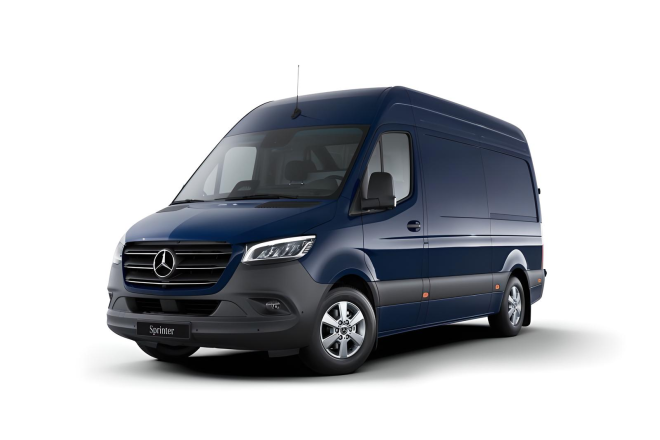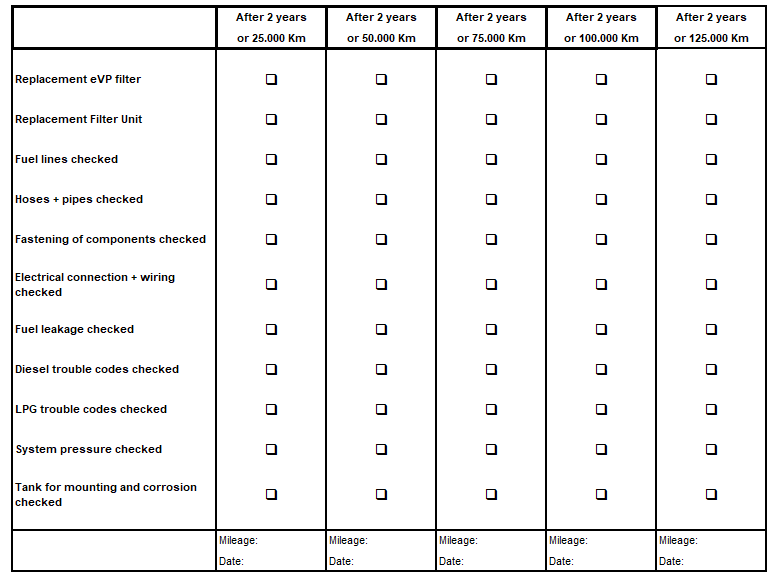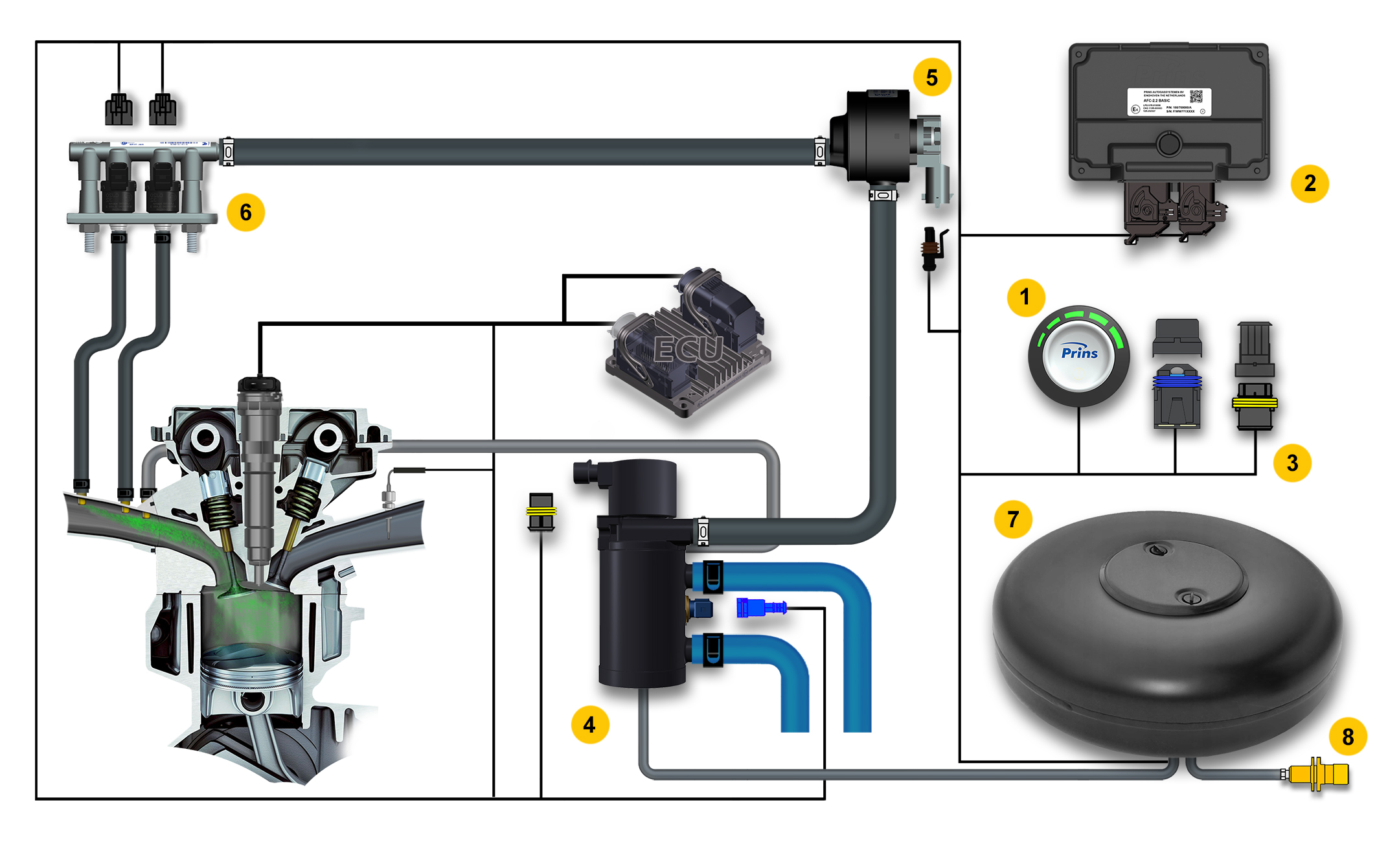Thank you for choosing to have your car equipped with an advanced Prins LPG Dual-Fuel LD system. This system meets strict legal requirements regarding safety and the environment.
Before driving a Dual-Fuel system, we recommend that you carefully read this service page. It will familiarize you with the necessary information about your Prins system.
This service page explains how to operate your LPG system. It also points you to important addresses you can consult if you have any questions or problems.
We wish you many enjoyable driving experiences.

General tips for driving on LPG Dual-Fuel
1. Primary fuel: Diesel remains the engine's primary fuel source.
LPG is used as a supplement to diesel under specific engine load and speed conditions.
Prevent running dry: Always ensure there is sufficient diesel in the tank, as diesel is continuously consumed while driving.
2. Abnormal combustion:
If you hear unusual engine noises, immediately switch back to diesel by pressing the fuel selector switch.
If the engine runs and sounds fine in diesel mode, continue your journey in diesel mode and visit an authorized Prins dealer as soon as possible. If the unusual noise persists, even in diesel mode, turn off the engine and call roadside assistance.
3. If you smell gas in or around your car, switch to diesel immediately and have your car checked as soon as possible by the nearest LPG specialist.
4. To ensure a long life and trouble-free driving on LPG, follow the prescribed maintenance instructions. We recommend having a maintenance check performed every 25,000 km or every two years by an authorized Prins LPG installer. The items included in this maintenance check can be found in the table at the bottom of this page.
5. After installing your Prins system, you should receive a warranty certificate from your installer. This warranty certificate lists all vehicle and system details. Your warranty period begins on the date of installation.
6. Driving/parking LPG cars in underground garages is generally permitted. Only in some parking garages are restrictions imposed by the owner of the garage. The owner can enforce this through signage. The garage owner is free to include this in the house rules, which must then be adhered to.
AUTOGAS
Autogas or LPG (Liquefied Petroleum Gas), like gasoline and diesel, consists of hydrocarbon compounds. The main components of LPG are propane and butane. Both the extraction of oil and natural gas, and the refining of crude oil, release large quantities of petroleum gases. Compressing these petroleum gases liquefies them, creating LPG. LPG is a cleaner fuel compared to gasoline and diesel. Using LPG as a motor fuel therefore contributes to better air quality. LPG is an odorless gas with an added odorant, making any leaks easily detectable.
The fuel selector switch is located on the dashboard or center console. The fuel selector switch controls the Dual-Fuel system.
The AFC computer is mounted in the engine compartment. This computer is the heart of the LPG system. The AFC processes all incoming signals and controls all actuators.
The LPG system is separately fused and has a diagnostic connector for reading the system.
eVP-500 reducer
The electronically controlled eVP-500 reducer is mounted in the engine compartment. The eVP-500 ensures that the liquid gas from the tank is evaporated. It also regulates the pressure to a variable operating pressure.
Temperature sensor
The temperature sensor is located in the reducer and measures the coolant temperature in the reducer. This temperature is used, among other things, to determine the switch-on time.
Actuator + filter
This component has three different functions:
1) It electronically regulates the dynamic LPG pressure in the system.
2) It automatically shuts off the LPG supply when switching back to diesel operation, when the engine stops/stalls, and in the event of a malfunction.
3) Simultaneously, the LPG is filtered.
Filter unit
The filter unit is located between the evaporator and the injector rail. It filters the dry gas, protecting the injectors from contamination.
Combined pressure/temperature sensor
The combined pressure/temperature sensor is integrated into the filter unit. This sensor measures the pressure and temperature of the gas.
The injector rail is mounted as close as possible to the intake manifold. The injectors that inject the vaporous gas are located in the injector rail.
LPG Tank
The LPG tank can be installed in the cargo area or under the vehicle. The LPG tank stores the liquid LPG under pressure. The LPG tank is equipped with an accessory housing containing various safety accessories.
Tank Shut-Off Valve
A shut-off valve is mounted on the tank. When switching back to diesel operation, stopping/cutting off the engine, or experiencing a malfunction, the LPG supply is automatically shut off.
Tank Level Sensor
The tank level sensor is mounted in the LPG tank. The tank level sensor is an electrical sensor that registers the liquid level in the tank.
80% Filler Valve
The tank is equipped with a fill safety valve, which ensures that only 80% of the tank can be filled.
Pressure Relief Valve
The tank is equipped with a pressure relief valve (PRV) that opens if the tank pressure becomes too high.
The filler is mounted on the outside of the vehicle. It has a protective cap. This cap must be removed during refueling. The external filler has a non-return valve that prevents the LPG from flowing back after refueling.
Information by topic
Starting
The engine always starts on diesel. Depending on the engine temperature and after performing the system check, it will automatically switch to Dual-Fuel mode.
Fuel Selector Switch
The fuel selector switch has two modes:
1. Diesel mode: Status LED (Prins logo) is off.
2. LPG/Dual-Fuel mode: Status LED (Prins logo) is on.
The brightness of the LEDs depends on daylight!
Switching from Diesel to LPG and Vice Versa
You can switch between diesel and Dual-Fuel mode at any time while driving by pressing the fuel selector switch. After pressing the switch, the switching procedure will begin.
Diesel >> Dual-Fuel: The status LED flashes. Once the switch has been switched, the status LED will be on continuously.
Dual-Fuel >> Diesel: The status LED will turn off once the switch has been switched to diesel.
LPG Tank Level Indicator
The tank level indicator is displayed using five tank level indicator LEDs. Depending on the type of tank sensor, the level indicator is displayed in 5 or 6 steps. When the red LED illuminates, the last liters of LPG available for use have been reached. This does not mean the tank is empty, but rather that, depending on the size and shape of the LPG tank in your car, there are still a few liters of LPG available. Due to the system's tank level measurement principle, this measurement cannot be more accurate and remains an indicative tank level measurement. Experience will tell how long you can still drive on Dual-Fuel after the red LED illuminates.
Empty Tank Situation
During an empty tank situation, the system automatically switches back to 100% diesel, the status LED flashes, and the beeper beeps 3 times. Pressing the selector switch returns to diesel mode, the status LED turns off, and the red tank level indicator LED remains illuminated. Once the tank is full again, you can switch back to Dual-Fuel.
If your car does not run on Dual-Fuel, please follow the checklist below.
• Is the LPG tank sufficiently filled?
• Is a fuse in the LPG system blown (always located at the LPG computer)?
Never install a larger fuse than indicated on the fuse wire, as this can damage the system! If you cannot resolve the problem, contact your Prins dealer. Never attempt repairs or adjustments yourself; have them done by an authorized Prins dealer. Otherwise, the warranty on your Prins system will be jeopardized.
Fuel Switch Diagnostics
For diagnostic purposes, a diagnostic/system check LED and a beeper are integrated into the switch. The following error messages may occur:
1. Non-critical system error: Diagnostic LED flashes.
Diagnosis: A malfunction has occurred in your LPG system. Driving on dual fuel remains environmentally responsible, but driving comfort may be reduced.
Action: Consult your Prins dealer.
2. Critical system error: The system automatically switches back to diesel mode, the beeper is activated, the status LED flashes, and the diagnostic LED is on.
Diagnosis: A fault has occurred in your LPG system. Driving on dual fuel is not recommended. Therefore, the system automatically switches to diesel.
Action: Turn off the beeper by pressing the fuel selector switch.
Consult your Prins dealer.
Filling the LPG tank:
Step 1. Turn off the engine!
Step 2. Remove the dust cap from the external filler.
Step 3. There are different types of fillers. Which one do you have?
Bayonet filler: Place the filler nozzle over the external filler and turn it a quarter turn to the right or left. Fully tighten the locking lever on the filler nozzle.
ACME (Euro) filler: Screw the nut of the filler nozzle onto the external filler. Press the locking lever on the filler nozzle.
Dish (Italy) filler: Place the filler nozzle in the external filler. Press the locking lever on the filler nozzle.
Euro nozzle filler: Place the filler nozzle in the external filler. Press the locking lever on the filler nozzle.
Step 4. Press the button on the LPG pump. When the pump stops after a while, the maximum tank level of 80% has been reached. Releasing the button stops filling.
Step 5. Now release the locking lever (some LPG may leak) and remove the fuel nozzle.
Step 6. Replace the dust cap to prevent dirt, water, sand, and dust from entering the filler neck and thus the system.
Note: Open flames and smoking are prohibited while refueling. Mobile phones must also be switched off.
Disassembly of components/systems
Never disassemble any components of the LPG system. The system is pressurized and contains liquefied gas. Disassembly poses a risk of burns. Have the system removed only by an authorized Prins dealer.
Gas Leakage
If you smell LPG, immediately switch to 100% diesel and contact an authorized Prins dealer.
Fire
In the event of a fire, leave the vehicle and maintain a safe distance. The LPG tank is equipped with a safety valve that releases the LPG in a pulsating manner as soon as the pressure in the tank becomes too high. This prevents the tank from exploding. Inform emergency responders that your vehicle has an LPG system.
When driving on LPG Dual-Fuel, maintaining your car is just as important as when driving on diesel.
To drive smoothly on Dual-Fuel, you must adhere to the following maintenance instructions and tips:
• General car maintenance must be carried out in accordance with the car importer's instructions.
• Maintenance must then be demonstrable (by means of a fully completed maintenance log) as specified by the importer.
• Maintenance must be carried out by a dealer designated by the importer.
• Adjustments and repairs to your Prins system may only be carried out by an authorized Prins dealer.
We recommend having a maintenance check performed every 25,000 km or every two years by an authorized Prins LPG installer. The items included in this maintenance check can be found in the table below:

General guidelines for damage repair work in a spray/drying booth
When repairing a car equipped with an LPG tank and placing the car in a spray/drying booth with a drying temperature higher than 60°C, the LPG tank must be removed. This is to ensure that the opening pressure of the pressure relief valve is not exceeded.
General guidelines for dismantling an LPG vehicle
When dismantling (demolition) a vehicle equipped with an LPG system, the LPG tank and its piping must be taken into account due to the possible residual pressure in these areas. The LPG tank must also be removed before the vehicle is crushed.
LPG fuel quality
The LPG fuel must meet the minimum DIN EN 589 standard. All warranties are void if a different fuel quality is used.
Part of the General Terms and Conditions. These general terms and conditions were filed with the Chamber of Commerce and Industry in Eindhoven on January 3, 2011, under number 17058344.
Warranty
14.1 Prins warrants that the Products supplied by Prins are manufactured of sound materials and good workmanship. Should any defects nevertheless occur in the Products supplied by Prins due to manufacturing and/or material errors, Prins will, after inspection in accordance with Article 14.3, repair these defects within the period specified by Prins, or provide the necessary parts for repair, replace the Products in question in whole or in part, or reimburse a maximum of the invoice value of the Products, at Prins's sole discretion. This warranty is valid for twenty-four (24) months after delivery.
14.2 If the delivered Product includes a complete LPG system, it must be installed by Prins or a Prins-approved dealer, in accordance with the standard installation instructions and legal requirements. If the system has been registered online (warranty portal) within 30 days, the warranty period referred to in Article 14.1 will be thirty-six (36) months upon commissioning of the system, unless otherwise agreed in writing. If no online registration (warranty portal) has been performed, the warranty period of twenty-four (24) months will commence on the date of delivery.
14.3 The Purchaser is obligated to allow an expert designated by Prins, at Prins's request, to inspect the defective Product. Failure to do so will void the warranty. The expert's decision is binding on both parties. The costs of the aforementioned expertise will be borne by Prins if the Purchaser has legitimately made a warranty claim; otherwise, the costs will be borne by the Purchaser.
14.4 Claims under this warranty must be reported to Prins by registered letter within eight days of the discovery of a defect. Failure to submit a timely complaint will result in the lapse of all rights. Legal proceedings in this regard must be initiated within thirteen (13) months of the timely complaint, otherwise they will be forfeited.
14.5 If Prins, at the Purchaser's request, must repair the Products at the Purchaser's premises, Prins is authorized to charge the Purchaser for the costs incurred, including travel expenses, accommodation, and food.
14.6 Defects that occur in, or are wholly or partially the result of:
(a) failure to comply with user instructions, operating instructions, etc., or use other than intended normal use are excluded from the warranty;
(b) normal wear and tear;
(c) changes to the information on the warranty card;
(d) changes to the information on the government-required stickers provided by Prins; (e) assembly/installation, repair, or adjustment by third parties, or at least a dealer not authorized by Prins or the Purchaser, without prior written permission from Prins;
(f) the application of any government regulation regarding the nature or quality of materials used;
(g) materials provided by the Purchaser to Prins for processing or execution of an order, unless expressly agreed otherwise;
(h) materials and/or goods used in consultation with the Purchaser;
(i) advice provided by Prins, unless expressly agreed otherwise;
(j) the processing of Products by the Purchaser, unless Prins expressly states a specific processing method in writing in its documentation, brochures, etc., or has permitted this in writing without any reservation;
(k) due to external influences, installation errors;
(l) incorrect or inferior fuel;
(m) the use of an additive not approved in writing by Prins;
(n) demonstrable failure to comply with the maintenance schedule recommended by the car manufacturer, importer, and/or Prins.
14.7 If the Purchaser fails to comply, fails to comply properly, or fails to comply in a timely manner with any obligation arising from the Agreement concluded with Prins or any related agreement, Prins is not obligated to provide any warranty or compensation whatsoever with respect to the Agreement.
14.8 Any claim under this article shall lapse if the Purchaser proceeds or causes the Purchaser to carry out repairs, disassembly, or other work on the Products without Prins's prior written consent.
14.9 If Prins replaces parts or Products in fulfillment of the warranty obligation, the replaced Products or parts shall become its property. Prins is authorized to charge the transport costs of these (parts of the) Products, unless Prins has instructed the transport.
14.10 Any other obligation, such as compensation, without prejudice to the provisions of Article 15, paragraph 2, shall be excluded.





